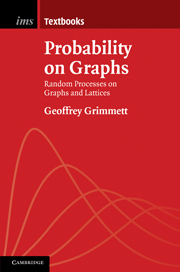Crossref Citations
This Book has been
cited by the following publications. This list is generated based on data provided by Crossref.
Graham, Benjamin
and
Grimmett, Geoffrey
2011.
Sharp thresholds for the random-cluster and Ising models.
The Annals of Applied Probability,
Vol. 21,
Issue. 1,
KELLER, NATHAN
2011.
On the Influences of Variables on Boolean Functions in Product Spaces.
Combinatorics, Probability and Computing,
Vol. 20,
Issue. 1,
p.
83.
2011.
An Introduction to Models of Online Peer-to-Peer Social Networking.
Jiang, Jianping
Zhang, Sanguo
and
Guo, Tiande
2011.
Russo's Formula, Uniqueness of the Infinite Cluster, and Continuous Differentiability of Free Energy for Continuum Percolation.
Journal of Applied Probability,
Vol. 48,
Issue. 3,
p.
597.
Keller, Nathan
2012.
A simple reduction from a biased measure on the discrete cube to the uniform measure.
European Journal of Combinatorics,
Vol. 33,
Issue. 8,
p.
1943.
Matúš, František
2012.
On conditional independence and log-convexity.
Annales de l'Institut Henri Poincaré, Probabilités et Statistiques,
Vol. 48,
Issue. 4,
Lammert, Paul E
Crespi, Vincent H
and
Nisoli, Cristiano
2012.
Gibbsianizing nonequilibrium dynamics of artificial spin ice and other spin systems.
New Journal of Physics,
Vol. 14,
Issue. 4,
p.
045009.
VAN ENTER, AERNOUT C. D.
IACOBELLI, GIULIO
and
TAATI, SIAMAK
2012.
POTTS MODEL WITH INVISIBLE COLORS: RANDOM-CLUSTER REPRESENTATION AND PIROGOV–SINAI ANALYSIS.
Reviews in Mathematical Physics,
Vol. 24,
Issue. 02,
p.
1250004.
van den Berg, J.
and
Jonasson, J.
2012.
A BK inequality for randomly drawn subsets of fixed size.
Probability Theory and Related Fields,
Vol. 154,
Issue. 3-4,
p.
835.
Leskelä, Lasse
and
Varpanen, Harri
2012.
Juggler's Exclusion Process.
Journal of Applied Probability,
Vol. 49,
Issue. 1,
p.
266.
Borsboom, Denny
and
Cramer, Angélique O.J.
2013.
Network Analysis: An Integrative Approach to the Structure of Psychopathology.
Annual Review of Clinical Psychology,
Vol. 9,
Issue. 1,
p.
91.
Ullrich, Mario
2013.
Comparison of Swendsen‐Wang and heat‐bath dynamics.
Random Structures & Algorithms,
Vol. 42,
Issue. 4,
p.
520.
van den Berg, J.
and
Gandolfi, A.
2013.
BK-type inequalities and generalized random-cluster representations.
Probability Theory and Related Fields,
Vol. 157,
Issue. 1-2,
p.
157.
Hu, Chenhui
Cheng, Lin
Sepulcre, Jorge
El Fakhri, Georges
Lu, Yue M.
and
Li, Quanzheng
2013.
Information Processing in Medical Imaging.
Vol. 7917,
Issue. ,
p.
1.
Sin, Duho
Kim, Jinsoo
Choi, Jee Hyun
and
Kim, Sung-Phil
2014.
Neuronal Ensemble Decoding Using a Dynamical Maximum Entropy Model.
Journal of Applied Mathematics,
Vol. 2014,
Issue. ,
p.
1.
Kroese, Dirk P.
Brereton, Tim
Taimre, Thomas
and
Botev, Zdravko I.
2014.
Why the Monte Carlo method is so important today.
WIREs Computational Statistics,
Vol. 6,
Issue. 6,
p.
386.
Jiang, Lintong
Wu, Xiaobing
Chen, Guihai
and
Li, Yuling
2014.
Effective On-Demand Mobile Charger Scheduling for Maximizing Coverage in Wireless Rechargeable Sensor Networks.
Mobile Networks and Applications,
Vol. 19,
Issue. 4,
p.
543.
Ericson, Josh
Poggi-Corradini, Pietro
and
Zhang, Hainan
2014.
Effective resistance on graphs and the epidemic quasimetric.
Involve, a Journal of Mathematics,
Vol. 7,
Issue. 1,
p.
97.
Mottram, Edward
2014.
Percolation with Constant Freezing.
Journal of Statistical Physics,
Vol. 155,
Issue. 5,
p.
932.
Cohen, Samuel N.
2014.
Undiscounted Markov Chain BSDEs to Stopping Times.
Journal of Applied Probability,
Vol. 51,
Issue. 1,
p.
262.



